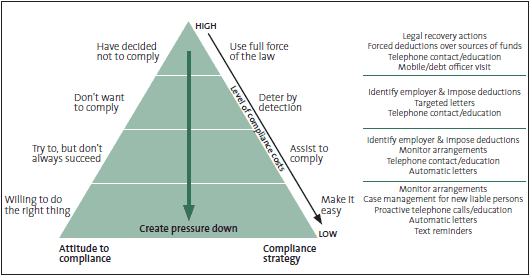Part 3: The strategy for managing child support debt
3.1
In this Part, we set out our findings about Inland Revenue's strategy to manage child support debt.
3.2
We expected Inland Revenue's child support debt strategy to include:
- clearly informing parents of their obligations while being responsive to their needs;
- promoting continuing voluntary payments of assessments;
- addressing the overall level of child support debt; and
- a clear and detailed understanding of the main drivers of child support debt, and using this information to inform and update its debt management strategies.
3.3
Overall, Inland Revenue needs to improve how it prevents child support debt from occurring in the first place. In our view, Inland Revenue needs to update its child support debt strategy to better inform parents about their child support obligations and how the scheme operates. Inland Revenue's child support debt strategy needs to better reflect how the penalty regime affects parents and their levels of debt. We acknowledge that Inland Revenue is legally obliged to implement the current penalty regime.
Debt compliance and enforcement strategy
Inland Revenue has a compliance and enforcement strategy guiding its overall approach to preventing child support debt. This strategy has not prevented that debt from growing significantly. Inland Revenue is beginning to create a new strategy for child support debt.
3.4
At the time of our audit, Inland Revenue was in the early stages of creating a new strategy to address the growth in child support debt. Inland Revenue's current debt strategy is part of its overall compliance and enforcement strategy, which was initially created in 2001 and updated in 2006. Inland Revenue's 2006 strategy update describes a general model for promoting compliance and enforcement of child support debt. This model (shown in Figure 4) is based on Inland Revenue's compliance model.
Figure 4
Inland Revenue child support scheme compliance and enforcement model

3.5
This model shows how people's attitudes about compliance relate to the actions Inland Revenue uses to encourage compliance. For example, the model states that Inland Revenue tries to make it easy for people who are "willing to do the right thing", and will assist those who "try to, but don't always succeed". The model also makes it clear that Inland Revenue will escalate the actions it takes to recover the debt when an individual chooses not to comply (the specifics of debt recovery are discussed in Part 7).
3.6
The 2001 strategy noted that "Child Support will remain in a phase of slowing down the growth of debt for another 3 to 5 years before debt starts to plateau and then decline." The 2006 strategy update noted that the compliance and enforcement measures Inland Revenue was taking would contribute to the "containment in the growth of child support debt in the short term, reduce debt over the longer term and promote future compliance."
3.7
We acknowledge that the strategy contributes to the collection of child support debt. However, the overall levels of child support debt growth are continuing to increase, fuelled in large part by compounding penalties and older debt. The existing strategies have been unsuccessful in preventing child support penalty debt from increasing significantly.
3.8
We acknowledge that Inland Revenue is legally obliged to implement the current penalty regime. Under that regime, the only way that overall debt levels will reduce is if there is 100% compliance – which we consider impossible to achieve in practice. With the current penalty regime and limited provisions available for writing off a debt, child support debt will inevitably increase.
3.9
Voluntary compliance is fundamental to Inland Revenue's compliance model. The child support scheme works best when parents pay voluntarily, so Inland Revenue does not have to pursue debts. Inland Revenue does not monitor or have any information on the number of private arrangements that are in place. We recognise that no child support scheme can satisfy all parents, but a scheme that satisfies the greatest number of parents (by being responsive to their needs) will be the most effective and efficient to administer.
3.10
We expected Inland Revenue's existing strategy to place more explicit emphasis on encouraging voluntary compliance. In particular, we expected a greater emphasis on informing parents of their obligations, as a way of encouraging liable parents to make their child support payments voluntarily. Additionally, we expected the strategy to better address the effect the penalty regime is having on the growth of debt, and how penalty levels may influence an individual's compliance. We discuss how the penalty regime may affect debt growth and the relationships between penalty levels and peoples' behaviour in greater detail in Parts 4 and 5.
3.11
Inland Revenue has assisted the Minister of Revenue in producing a discussion paper (not yet released) noting that aspects of the child support scheme may be out of date and could be undermining some parents' willingness to make child support payments. In our view, updating the scheme could increase voluntary compliance, making it more effective and more efficient to administer.
3.12
Inland Revenue is currently preparing a new debt strategy. In our view, this strategy needs to consider ways to encourage voluntary child support payments, and be responsive to the needs of parents. It also needs to clearly address the overall level of child support debt, and understand the drivers of child support debt. Inland Revenue needs to be clear about the specific outcomes it is trying to achieve with its debt strategy, so that it can monitor its performance towards those outcomes.
| Recommendation 1 |
|---|
| We recommend that the Inland Revenue Department update its child support debt strategy to better promote voluntary compliance by parents and better reflect the effect the penalty regime has on debt levels. |
3.13
Inland Revenue told us it accepts this recommendation and plans to incorporate it into the work it has under way in updating its debt strategy.

